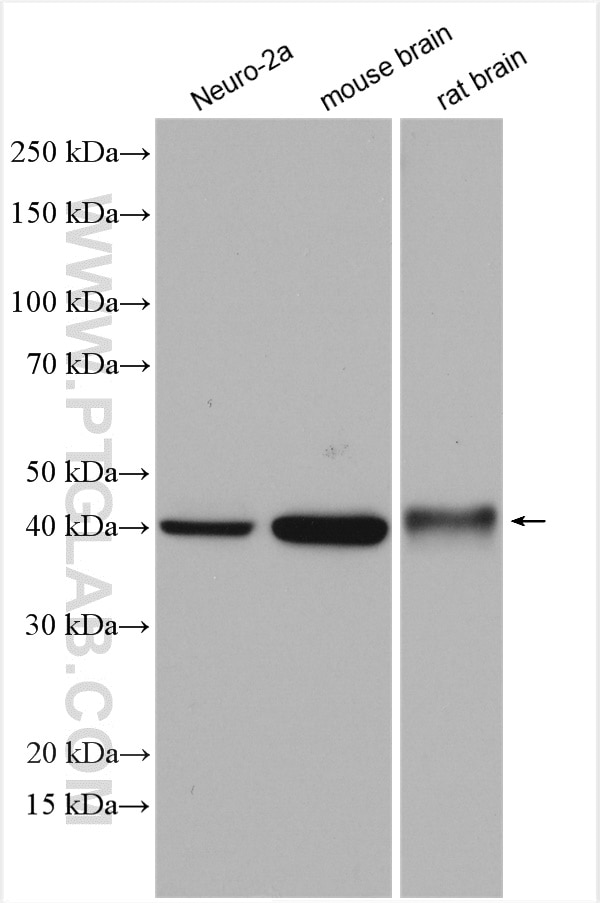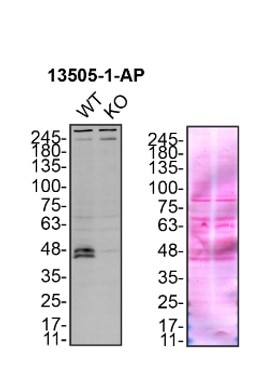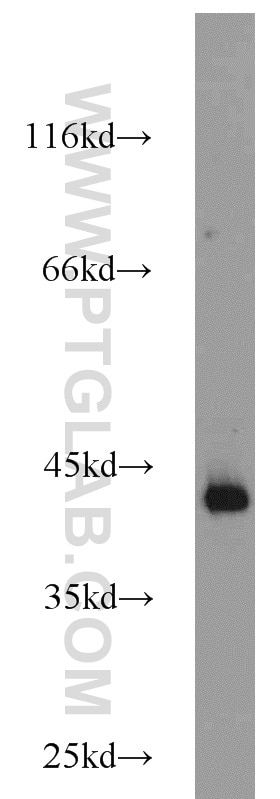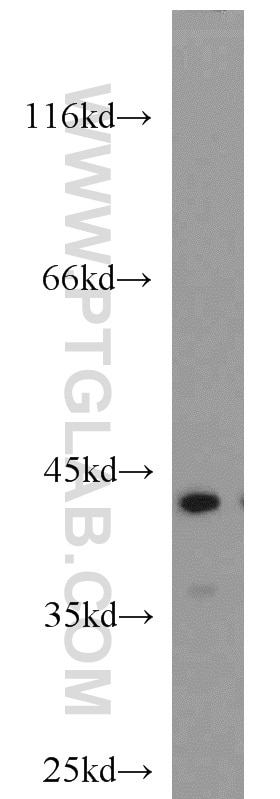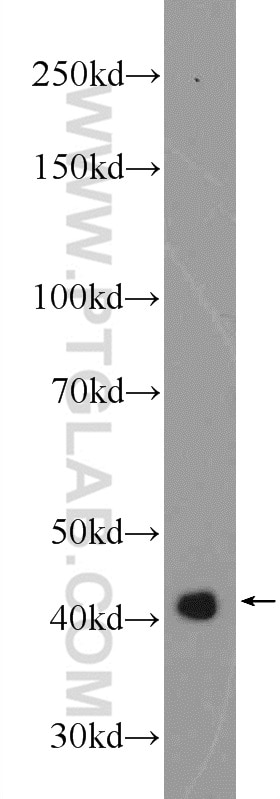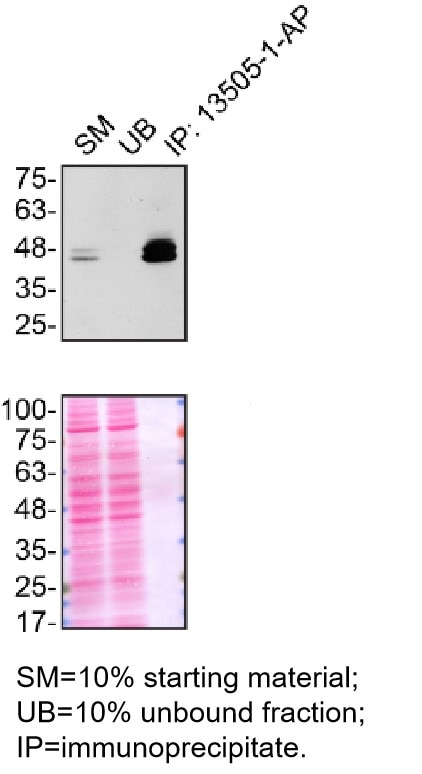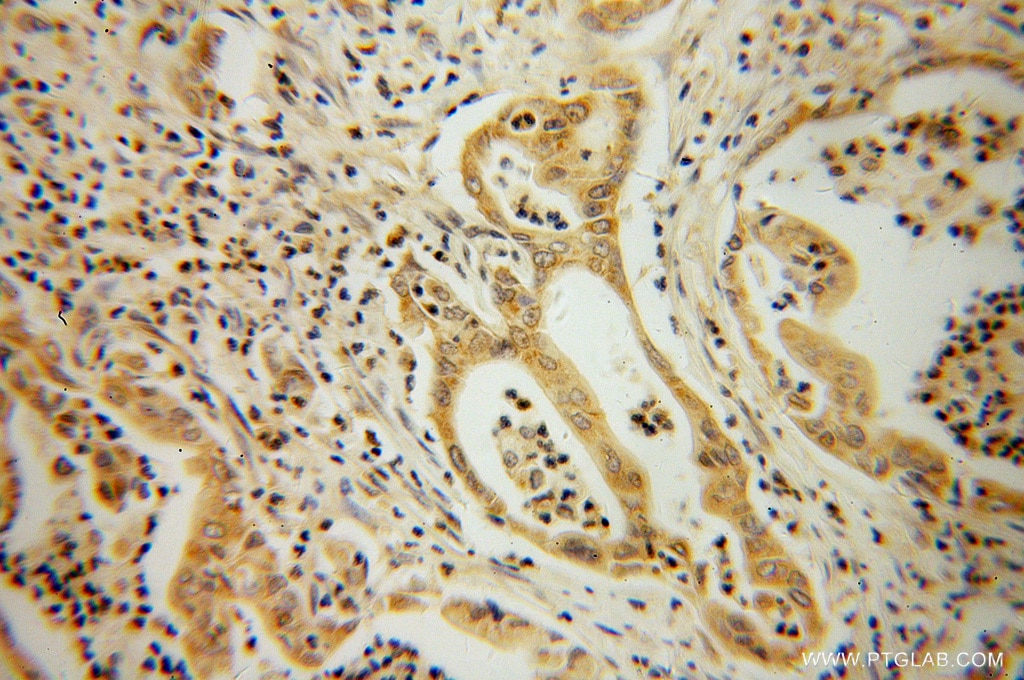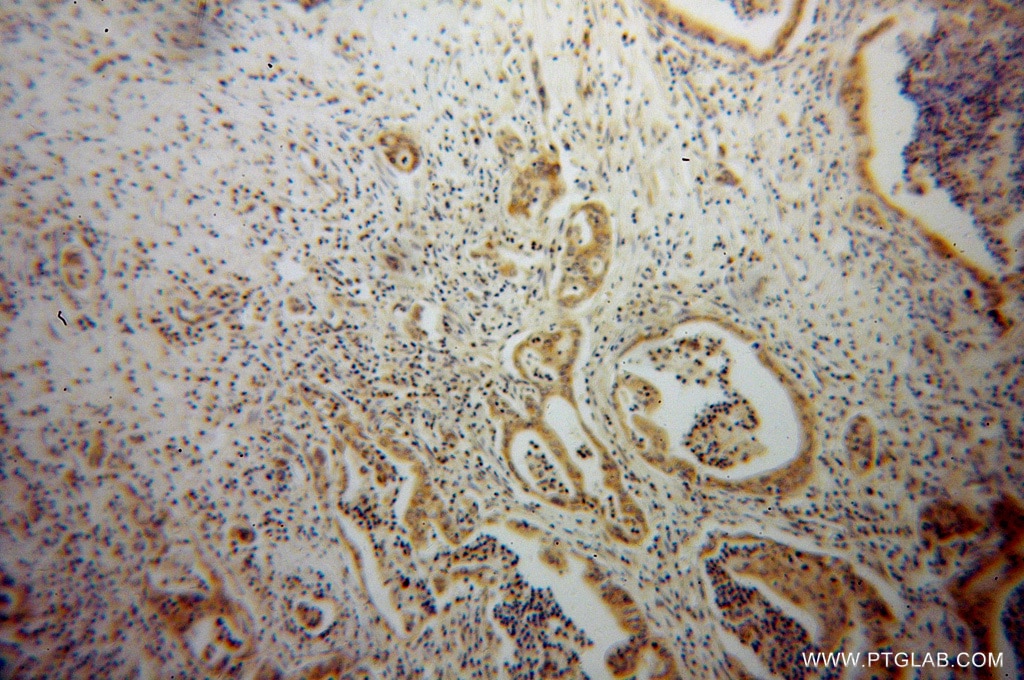- Phare
- Validé par KD/KO
Anticorps Polyclonal de lapin anti-ATX3,ATXN3
ATX3,ATXN3 Polyclonal Antibody for WB, IP, IHC, ELISA
Hôte / Isotype
Lapin / IgG
Réactivité testée
Humain, rat, souris et plus (2)
Applications
WB, IP, IF, IHC, CoIP, ELISA
Conjugaison
Non conjugué
N° de cat : 13505-1-AP
Synonymes
Galerie de données de validation
Applications testées
| Résultats positifs en WB | cellules Neuro-2a, cellules HEK-293, tissu cardiaque de souris, tissu cérébral de rat, tissu cérébral de souris, tissu placentaire de souris |
| Résultats positifs en IP | cellules HEK-293, |
| Résultats positifs en IHC | tissu de cancer du pancréas humain il est suggéré de démasquer l'antigène avec un tampon de TE buffer pH 9.0; (*) À défaut, 'le démasquage de l'antigène peut être 'effectué avec un tampon citrate pH 6,0. |
Dilution recommandée
| Application | Dilution |
|---|---|
| Western Blot (WB) | WB : 1:1000-1:4000 |
| Immunoprécipitation (IP) | IP : 0.5-4.0 ug for 1.0-3.0 mg of total protein lysate |
| Immunohistochimie (IHC) | IHC : 1:20-1:200 |
| It is recommended that this reagent should be titrated in each testing system to obtain optimal results. | |
| Sample-dependent, check data in validation data gallery | |
Applications publiées
| KD/KO | See 5 publications below |
| WB | See 18 publications below |
| IHC | See 3 publications below |
| IF | See 4 publications below |
| IP | See 1 publications below |
| CoIP | See 2 publications below |
Informations sur le produit
13505-1-AP cible ATX3,ATXN3 dans les applications de WB, IP, IF, IHC, CoIP, ELISA et montre une réactivité avec des échantillons Humain, rat, souris
| Réactivité | Humain, rat, souris |
| Réactivité citée | Humain, porc, souris, Caenorhabditis elegans |
| Hôte / Isotype | Lapin / IgG |
| Clonalité | Polyclonal |
| Type | Anticorps |
| Immunogène | ATX3,ATXN3 Protéine recombinante Ag4341 |
| Nom complet | ataxin 3 |
| Masse moléculaire calculée | 370 aa, 43 kDa |
| Poids moléculaire observé | 35-42 kDa |
| Numéro d’acquisition GenBank | BC033711 |
| Symbole du gène | ATXN3 |
| Identification du gène (NCBI) | 4287 |
| Conjugaison | Non conjugué |
| Forme | Liquide |
| Méthode de purification | Purification par affinité contre l'antigène |
| Tampon de stockage | PBS avec azoture de sodium à 0,02 % et glycérol à 50 % pH 7,3 |
| Conditions de stockage | Stocker à -20°C. Stable pendant un an après l'expédition. L'aliquotage n'est pas nécessaire pour le stockage à -20oC Les 20ul contiennent 0,1% de BSA. |
Informations générales
ATXN3, which has deubiquitinase activity and act as a component of the ubiquitin proteasome system, plays a role in transcriptional regulation and neuroprotection. ATXN3 interacts with RAD23, HHR23A and HHR23B, involves in the pathology of MJD. ATXN3 is a mixed-linkage, chain-editing enzyme and that the UIM region of ATXN3 regulates its substrate specificity. Contains an N-terminal deubiquitinating domain, called the Josephin domain, followed by 2 ubiquitin-interacting motifs (UIMs) and a polyQ tract near the C terminus. ATXN3 can be phosphorylated in a protein casein kinase-2-dependent manner, thus the MW would be larger than the predicted one.
Protocole
| Product Specific Protocols | |
|---|---|
| WB protocol for ATX3,ATXN3 antibody 13505-1-AP | Download protocol |
| IHC protocol for ATX3,ATXN3 antibody 13505-1-AP | Download protocol |
| Standard Protocols | |
|---|---|
| Click here to view our Standard Protocols |
Publications
| Species | Application | Title |
|---|---|---|
Nat Commun TSPAN8 promotes cancer cell stemness via activation of sonic Hedgehog signaling.
| ||
PLoS Genet The Role of the Mammalian DNA End-processing Enzyme Polynucleotide Kinase 3'-Phosphatase in Spinocerebellar Ataxia Type 3 Pathogenesis.
| ||
Sci Total Environ USP15 participates in DBP-induced testicular oxidative stress injury through regulating the Keap1/Nrf2 signaling pathway. | ||
PLoS Genet Inactivation of PNKP by mutant ATXN3 triggers apoptosis by activating the DNA damage-response pathway in SCA3. | ||
Neurobiol Dis A new humanized ataxin-3 knock-in mouse model combines the genetic features, pathogenesis of neurons and glia and late disease onset of SCA3/MJD. |
